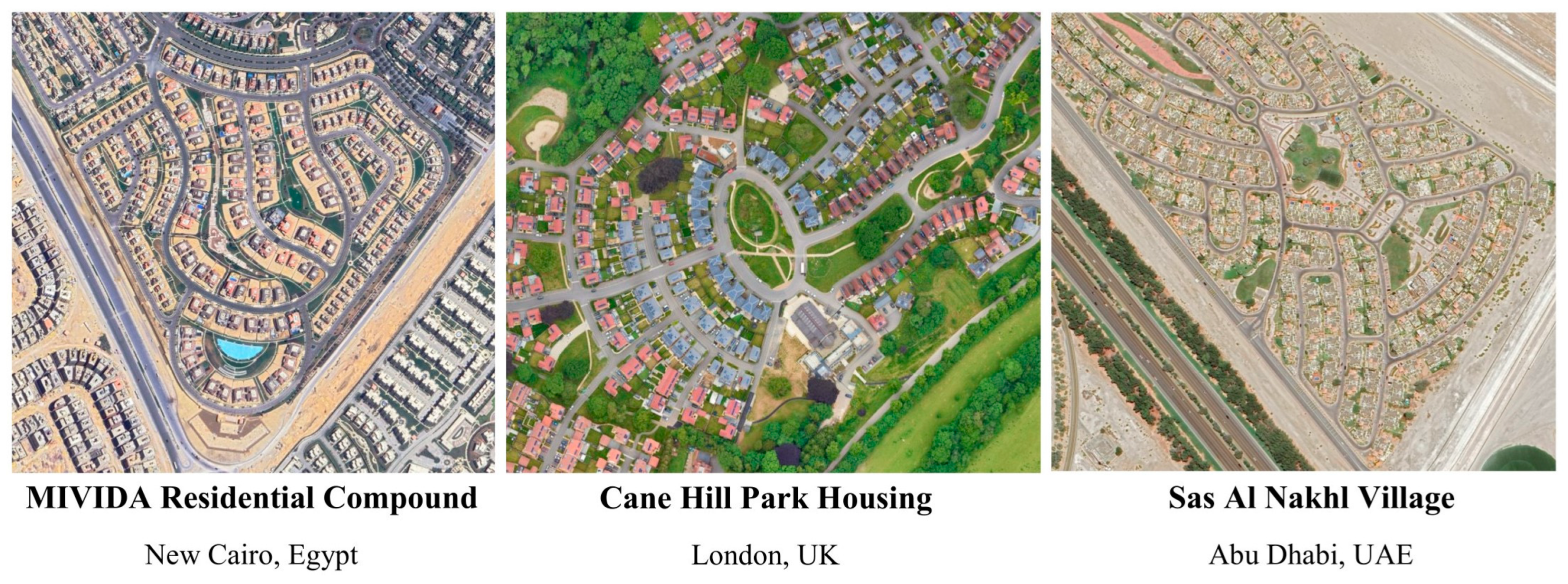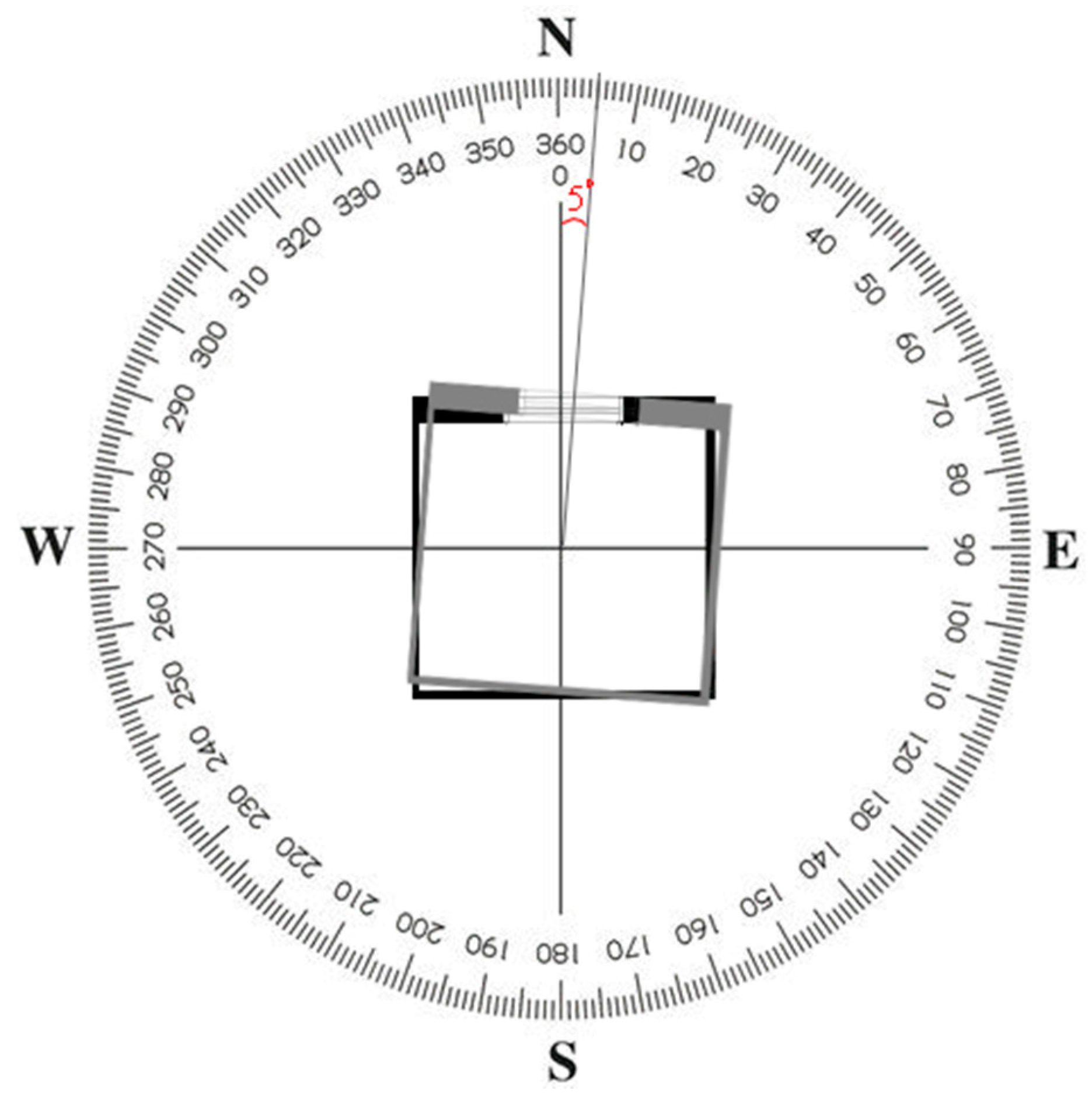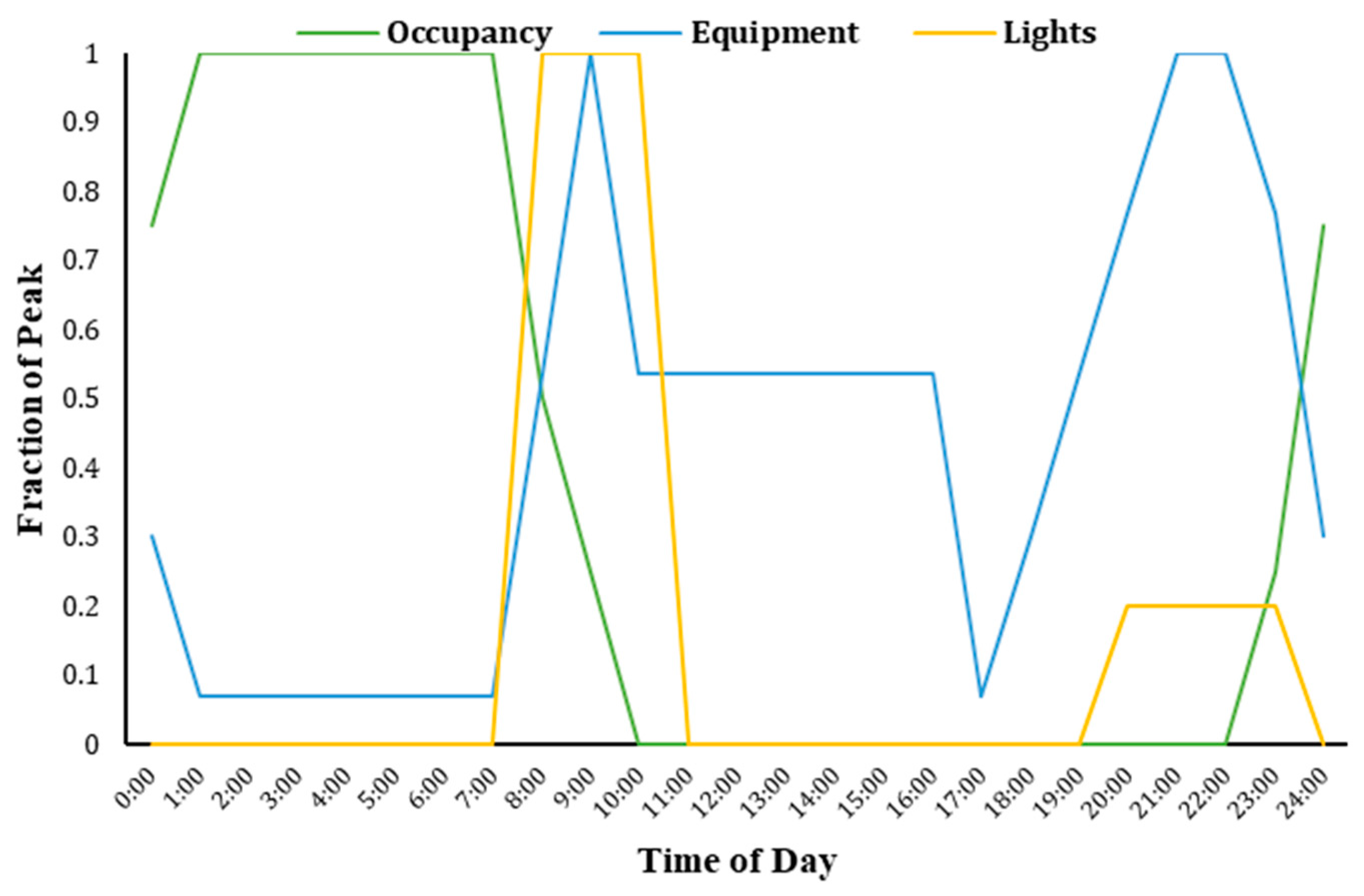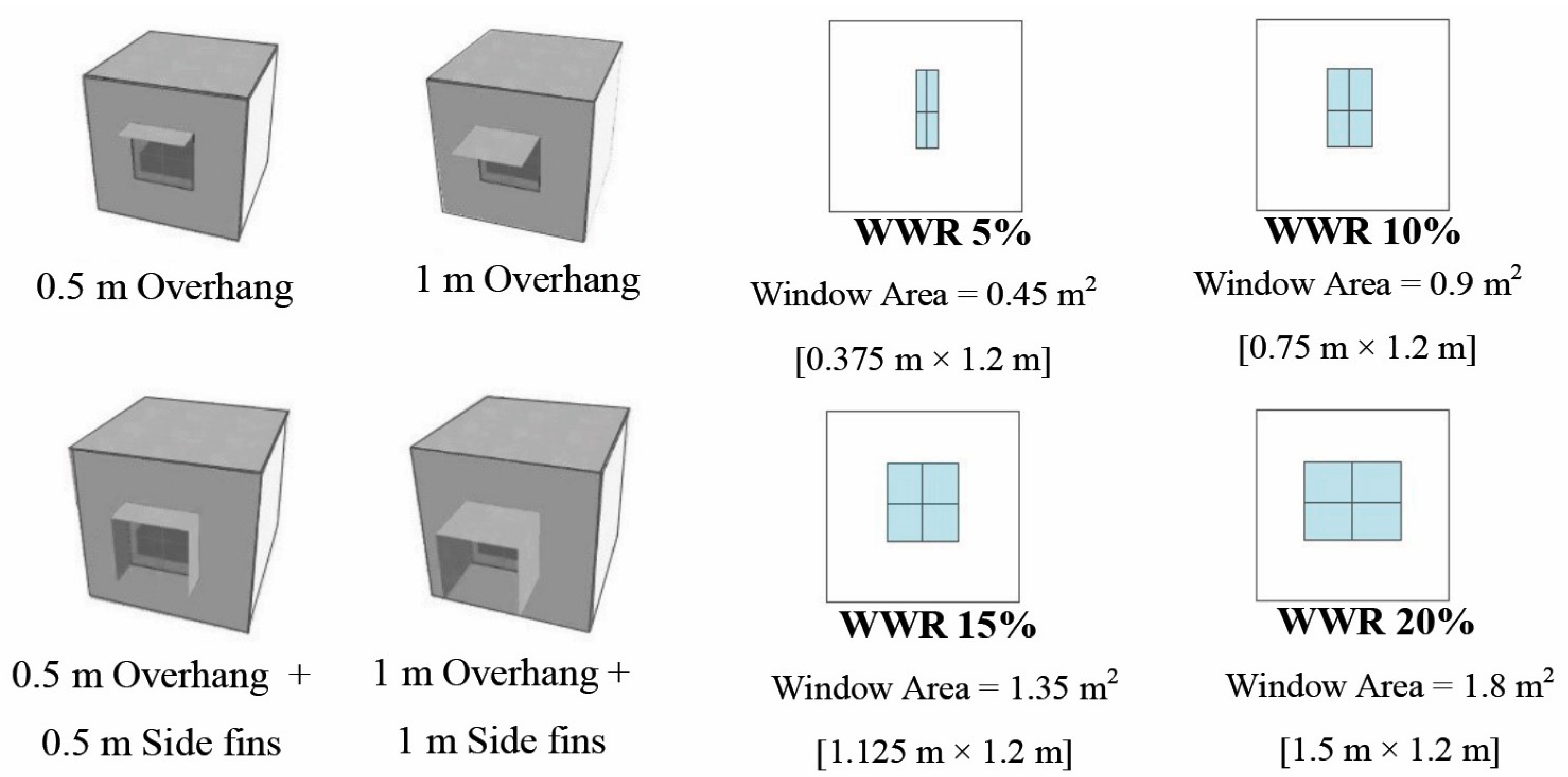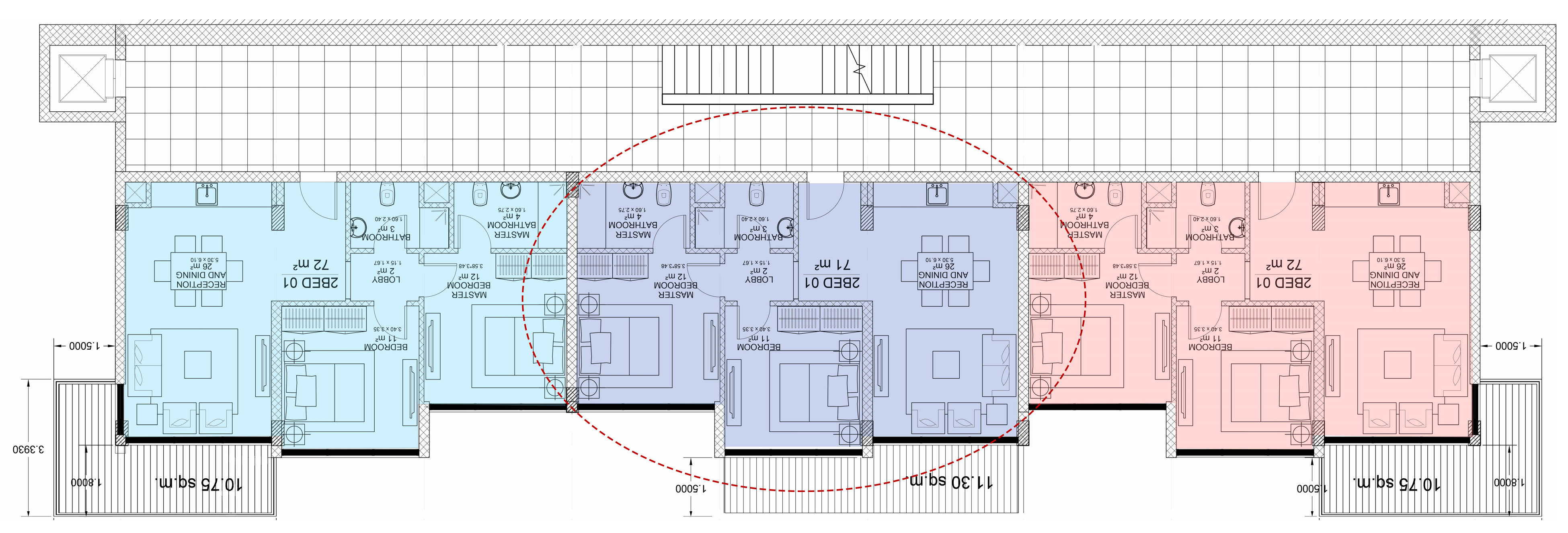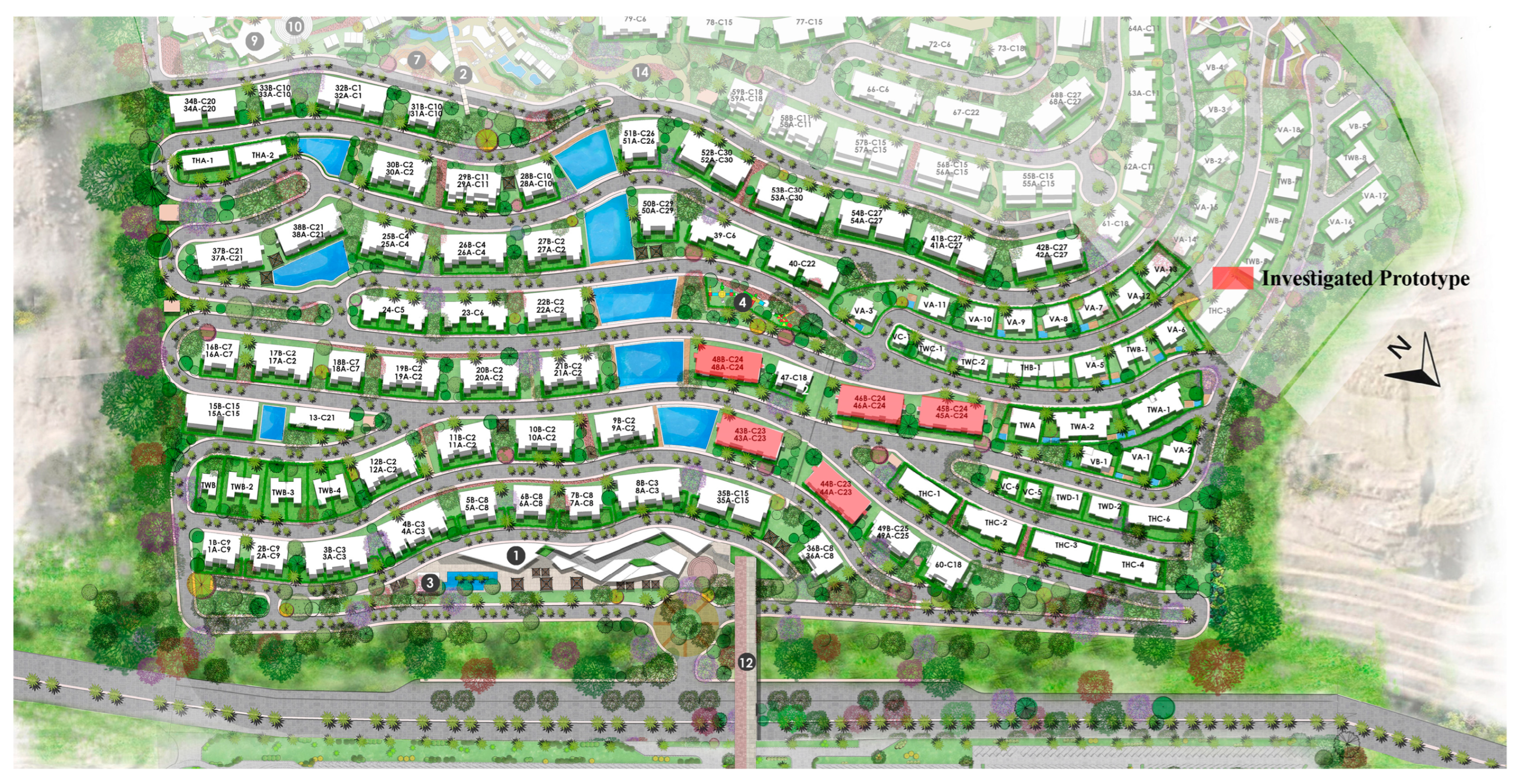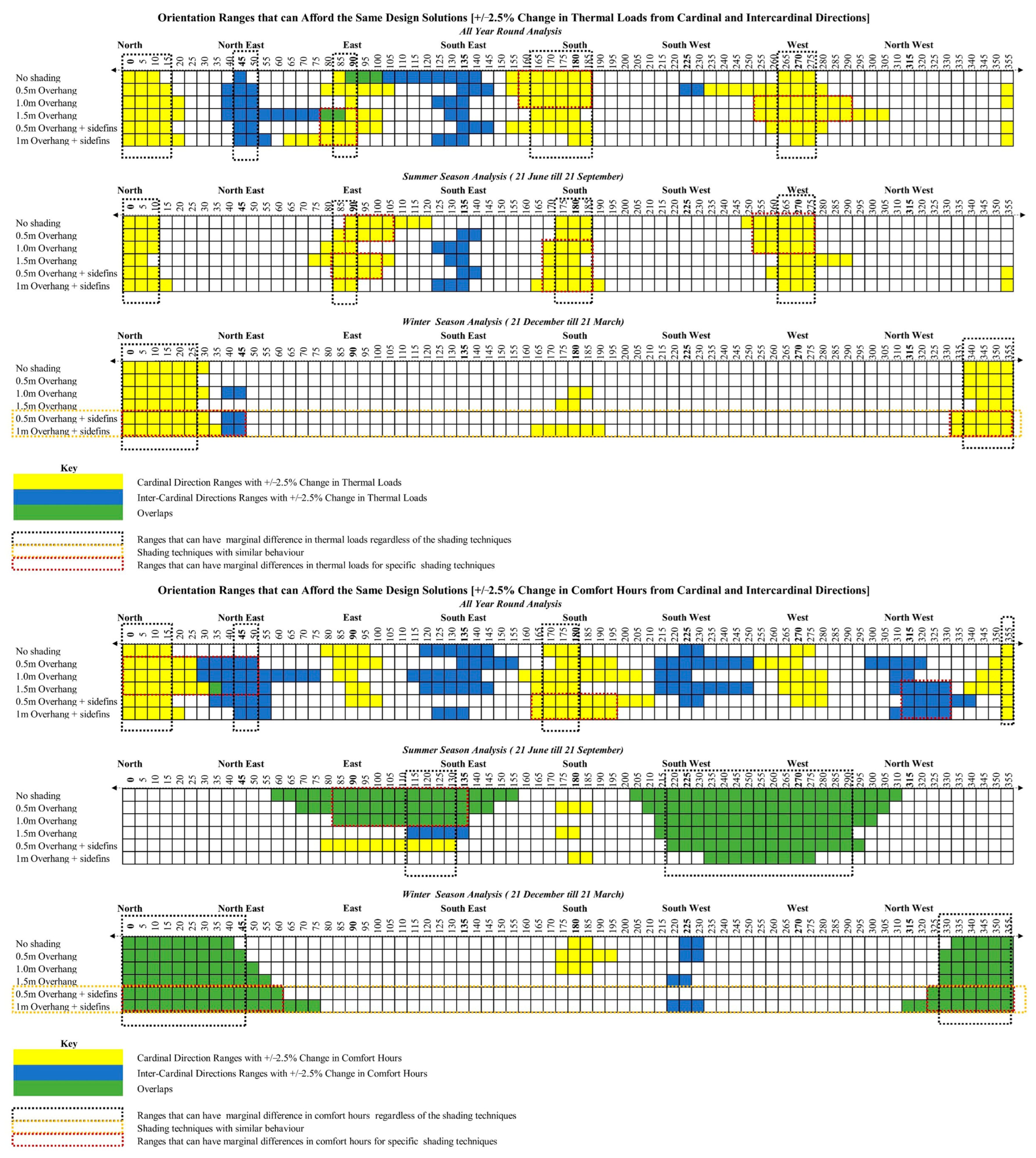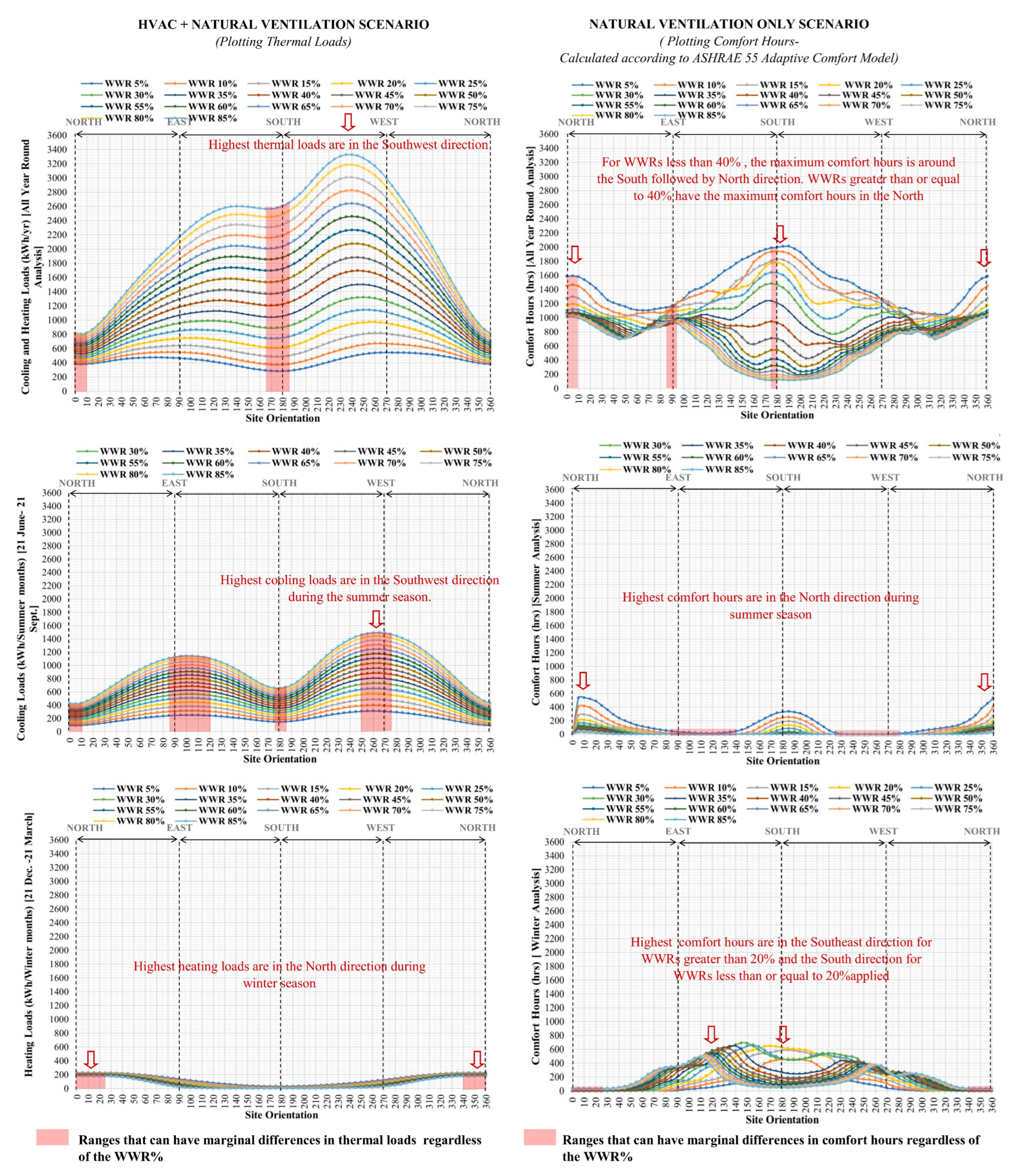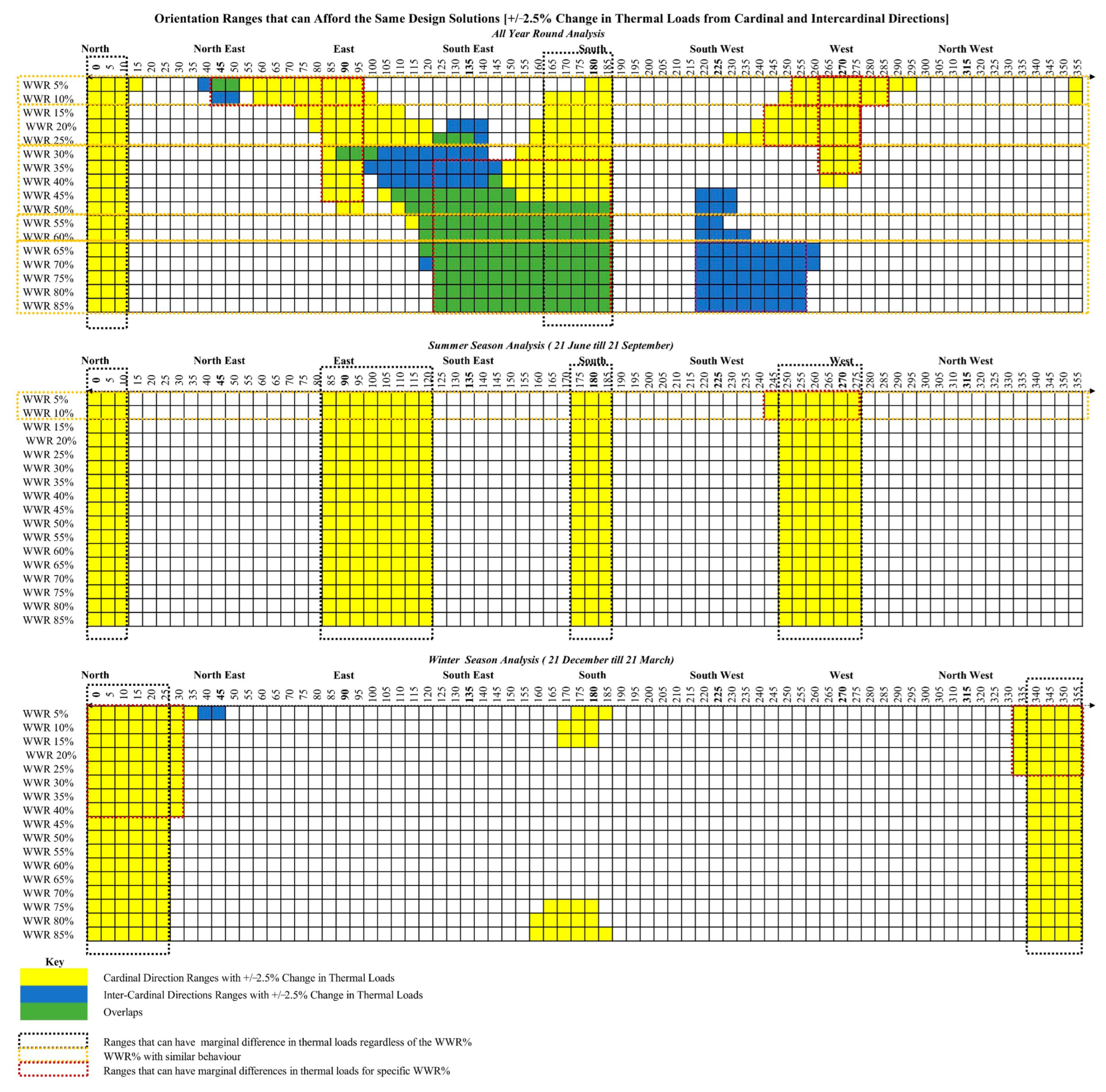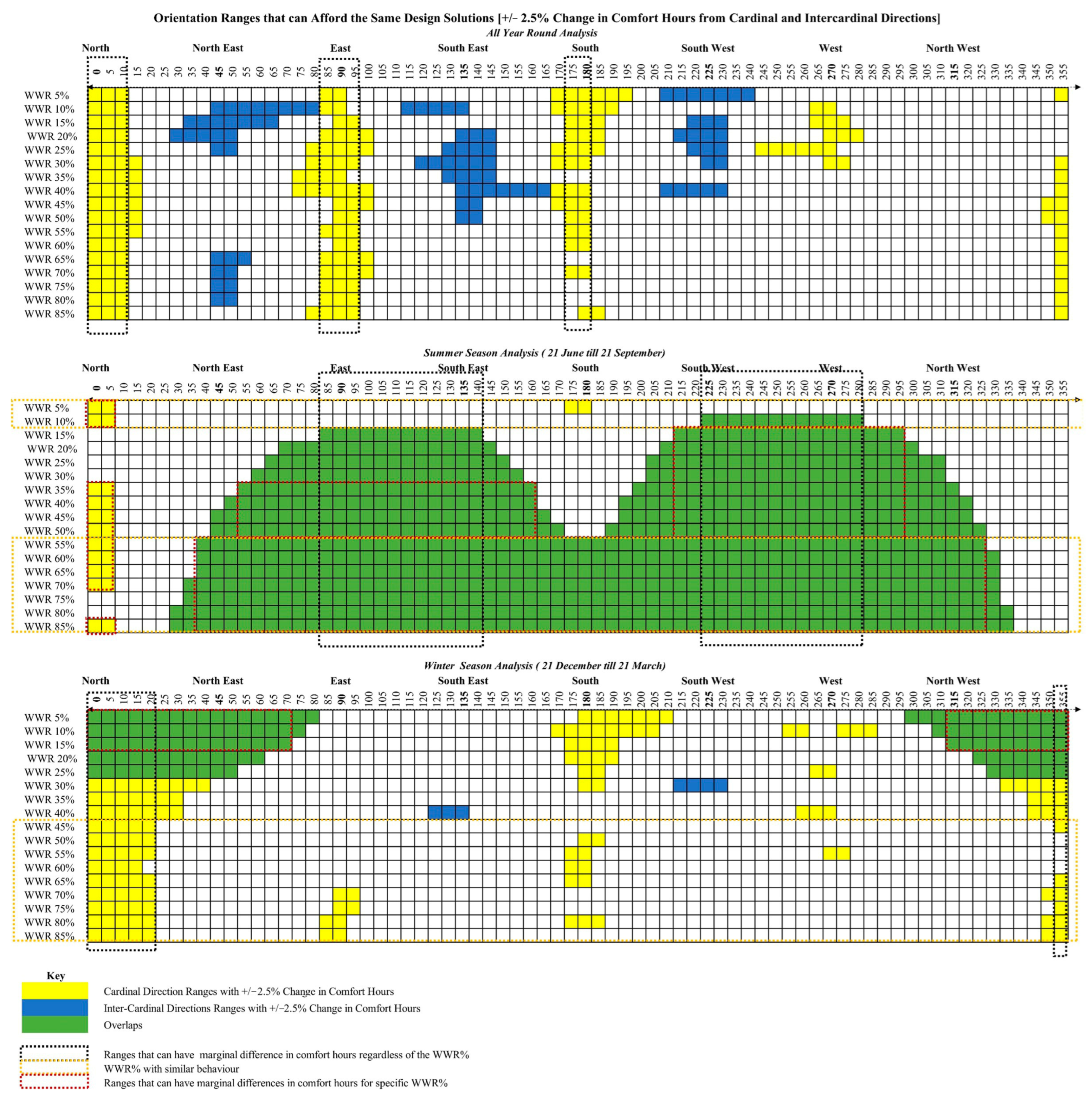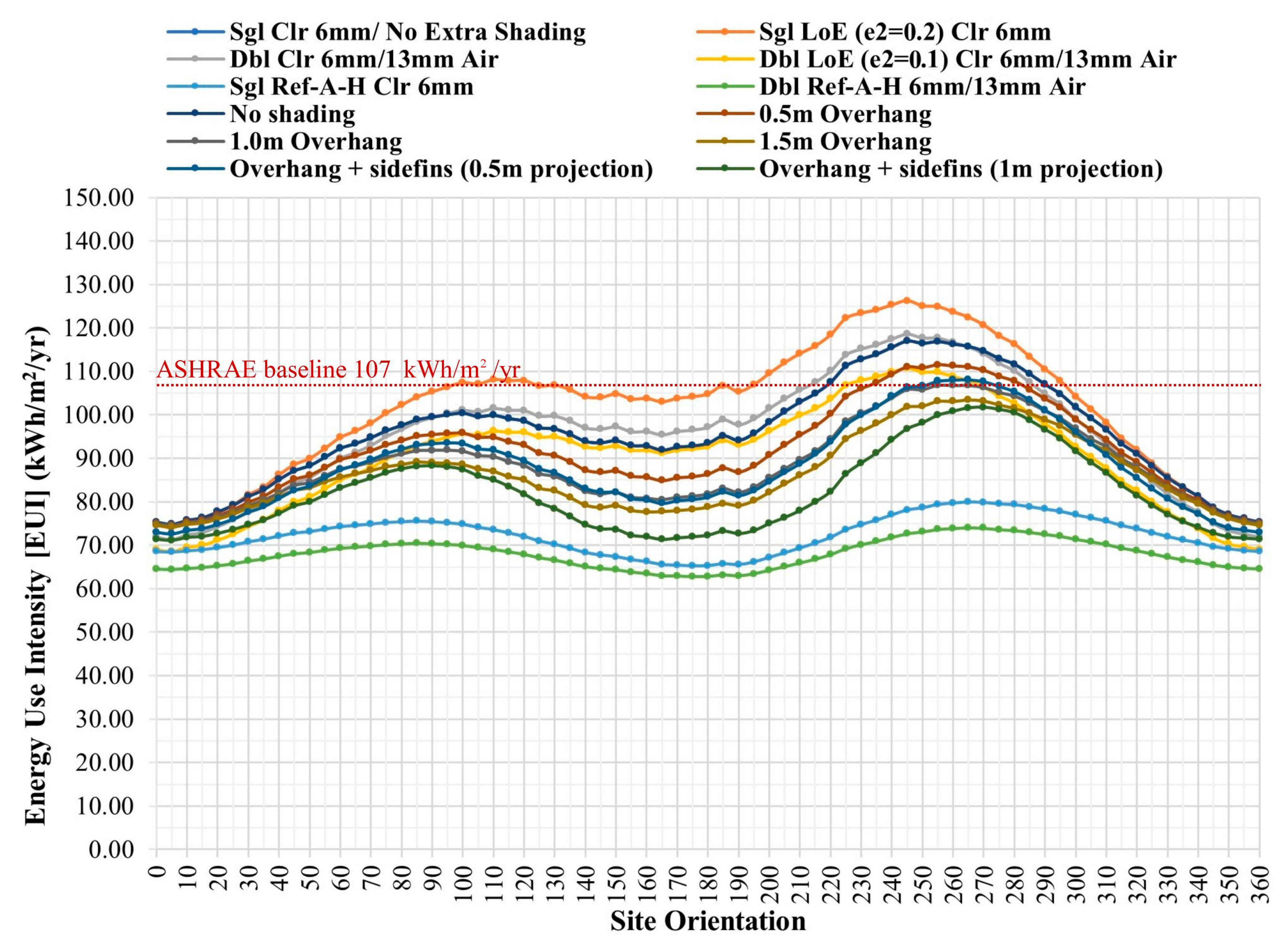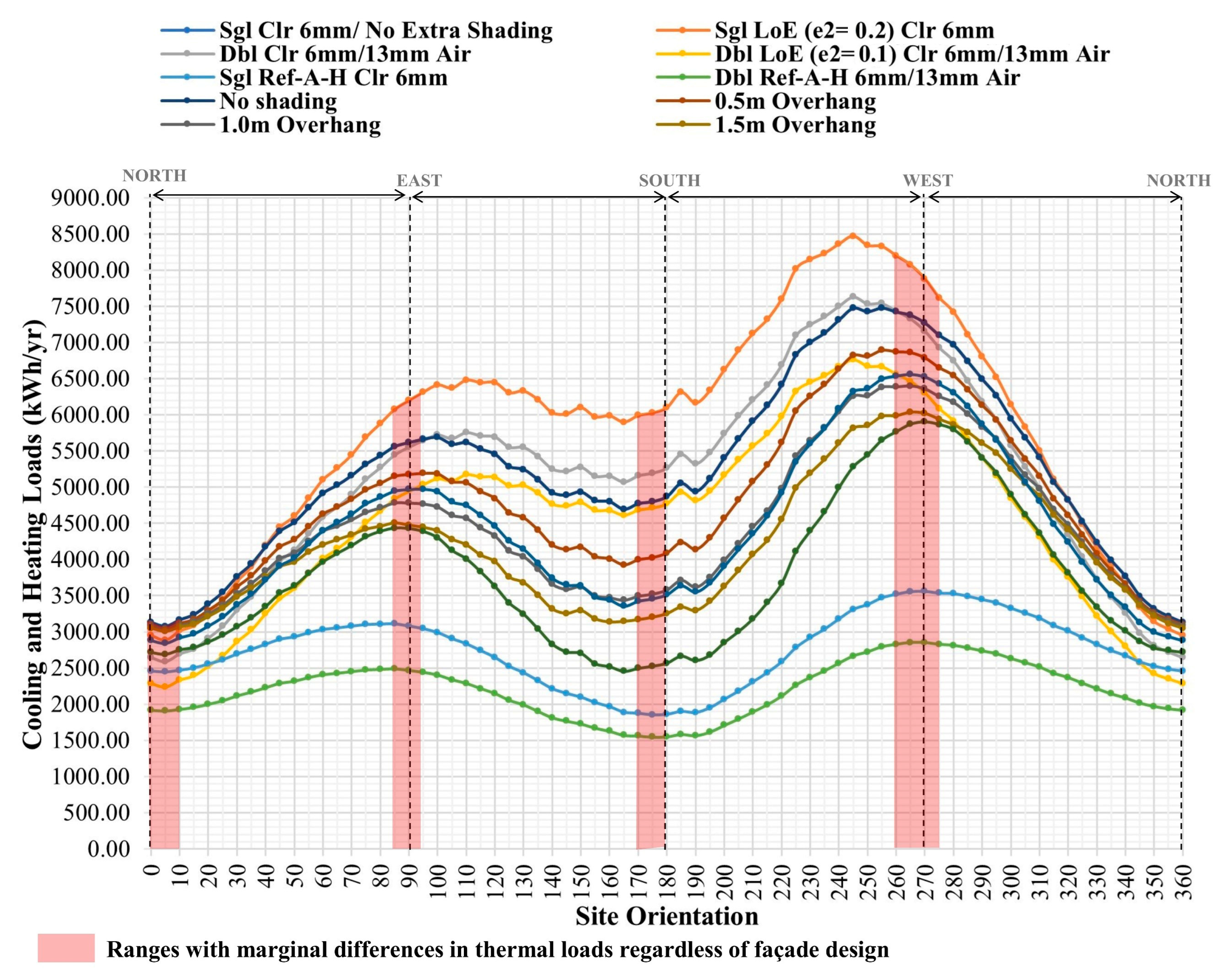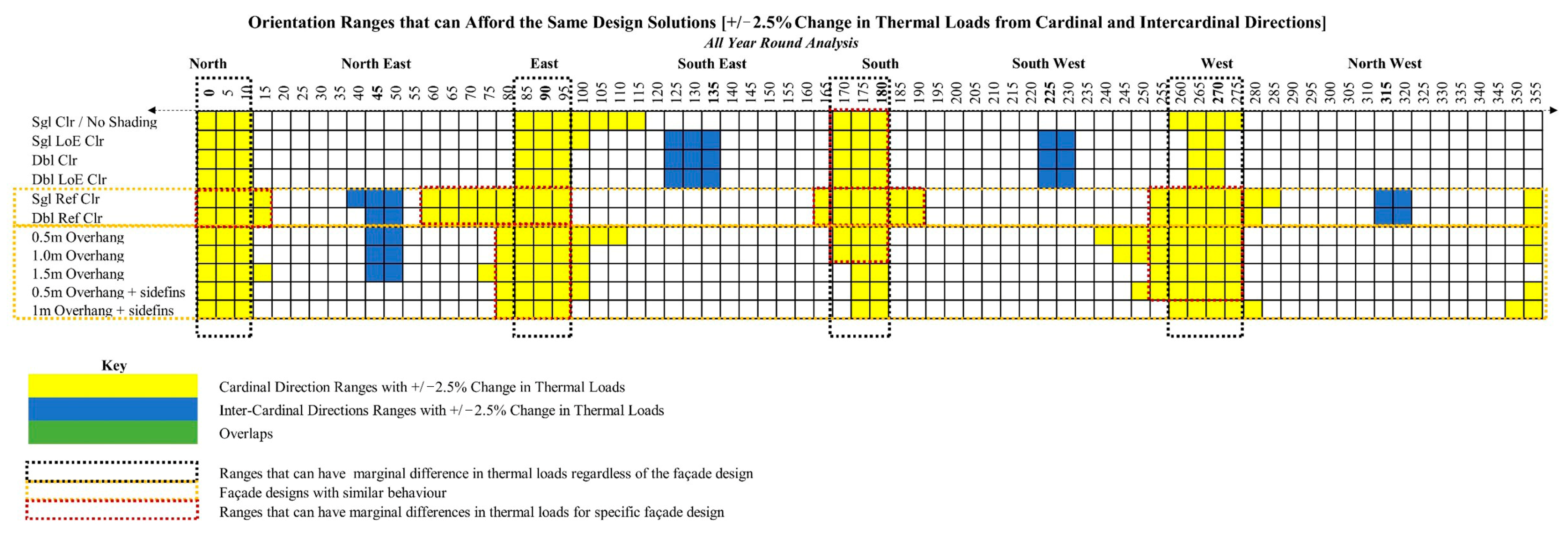1. Introduction
Buildings are responsible for around 40% of worldwide carbon emissions [
1]. According to the United Nations Environment Programme (UNEP) global status report for buildings and construction for 2022, the CO
2 emissions from building operations, which includes emissions from heating and cooling, have surged to a record high of roughly 10 GtCO
2, which is a 5% increase from 2020 and is 2% higher than the previous peak in 2019 [
2]. This research has also highlighted that building performance modeling should be used as early as possible in the design process to maximize its impact on crucial design decisions [
3]. According to de Wilde [
4] and Lin et al. [
5], 57% of energy-saving measures should be considered at the schematic design phase, as this is when the building shape, orientation, and skin begin to take shape. The potential for energy savings decreases as the design phases proceed, and the prices for the same energy-saving benefits rise [
4,
5]. Despite the growing interest in urban building energy modeling in large-scale master plan projects, there is still a need to introduce relevant tools at various stages of the planning and design processes, as well as to explore to what extent these tools might assist stakeholders in making decisions [
6]. Hemsath [
7] shows that individual home orientation has minimal cost implications, whereas the aggregated suburban community house orientation has more significant total annual energy costs.
To curb the existing trend of the unsustainable surge in energy demand, energy-efficient techniques for the residential sector need to be continuously developed as the energy consumption from residential structures is expected to increase by more than eight times by 2050 [
8]. Over the past few decades, myriad studies have tackled the optimization of building performance, with energy consumption being considered the most common optimization objective. A study by Evins [
9] reveals that more than 60% of the literature tackled energy consumption compared to other objectives such as cost, comfort, daylight performance, and CO
2 emissions. Proper building orientation can contribute to significant energy savings throughout a building’s life cycle [
10]. The impact of building orientation on energy savings is addressed in a study by Ruiz and Bandera [
11]. The authors state that the influence of orientation on energy demand can be attributed to the correlation between building orientation and important environmental factors such as incident solar radiation and wind exposure [
11]. The residential sector’s energy usage is also influenced by the building envelope and user behavior, while the most important factors impacting the thermal comfort and lighting energy requirements inside a building are the building design, orientation, and window-to-wall ratio [
12]. A recent study by Alsaadani [
13] provides a synthesis and thorough literature review on the research conducted to enhance building energy performance, particularly in the Egyptian Residential Sector. The author provided a breakdown of the various variables, methodologies, analysis types, performance objectives, and geographical locations of studies conducted over the past few decades. Alsaadani [
13] pinpointed the gaps and overlaps in the literature, highlighting the fact that three climatic zones in Egypt are understudied, including the “East Coast Climatic Zone”, which is one of the reasons why the selected apartment prototype on the Red Sea Coast was chosen for this study.
Numerous studies have examined the impact of building orientation in different climatic zones on buildings’ thermal load and energy consumption, including Al-Tamimi et al. [
14] for non-air-conditioned buildings in hot, humid climates and Morrissey et al. [
15] for the temperate oceanic climate of Melbourne, Australia. Furthermore, Belmahdi et al. [
16] investigated the impact of building orientation on energy consumption in the Mediterranean climate of Tetouan city. The analysis indicated that taking building orientation into account when designing allows for the lowest energy consumption needed to reach thermal comfort [
16]. Renuka et al. [
8] investigated the impact of building location and orientation on energy efficiency. The analysis was conducted on house models in Mumbai, Shillong, Delhi, and Chennai. The results of the analysis indicate that if the optimal parameters are implemented, the highest decrease in energy consumption percentage is when the building is facing north in both Delhi and Chennai [
8]. Similarly, Elghamry and Azmy [
17] explored the impact of building orientation on energy consumption for a domestic unit in Cairo, Egypt. The results of the analysis show that the energy use intensity of the north–south façades is nearly 10% less than that of the east–west façades and is the best orientation for the least energy consumption [
17]. A study by Elhadad et al. [
18] also discussed the impact of building orientation on energy performance for a residential unit in New Minia City, Egypt. The authors highlighted that the energy demand could be reduced by 5.8% if the building is oriented towards the north direction [
18]. The location of the actual building has a noticeable effect on the energy consumption by up to 67% in the investigated case [
18].
Meanwhile, Aydin et al. [
19] explored the optimum shading devices to decrease energy consumption on a hypothetical building oriented toward the cardinal directions. The two main parameters investigated in this study are the width of the shading device and the angle between the shading device and the window. The results indicate that a 50 cm-sized shading device is better than a 25 cm shading device width and that the best angle between the window and shading device for the southwest, southeast, and north façades is 90°; for the east and west zones façade 30°, south zone façade 75°, northeast zone façade 45°, and finally, for the northwest zone façade 15° [
19]. In addition, El-Deeb et al. [
20] highlighted that building forms with large aspect ratios are highly sensitive to orientation changes, especially in desert locations. Sherif et al. [
21] have conducted a study to examine the optimum solar screen opening proportions for balancing energy and daylight performance in different orientations in desert environments. While a 1:1 proportion was recommended for the southern orientation, screen opening proportions from 1:1 to 18:1 [Horizontal: Vertical] improve daylight performance in northern orientations [
21]. Likewise, a study by Kim et al. [
22] looks at how the size, position, and orientation of windows all affect the energy load. In this study, the authors highlighted that the window position has the biggest influence when WWR is 20% [
22]. Alghoul et al. [
23] conducted a study to investigate the influence of window-to-wall ratio (WWR) and window orientation (WO) on cooling, heating, and total energy consumption for a small office space in the city of Tripoli, Libya. Walls with WWR between 0 and 0.9 and with orientation varied in steps of 45° were considered [
23]. The authors deduced that the cooling energy consumption is substantially higher than heating energy consumption; however, when adding windows to southern walls, cooling consumption drastically increases, while heating energy consumption decreases to zero due to passive solar heating [
23]. The effects of various façade design elements on the interior air temperatures and cooling loads in residential buildings in temperate climates were also studied by Tong et al. [
24]. The authors concluded that full-height clear glazing and unshaded facades exhibit the worst performance [
24]. They also noted that lowering the WWR to 40% and lowering the glass’s solar heat gain coefficient from 0.82 to 0.47, or adding a 1.5-m horizontal overhang above the window, can significantly lower indoor air temperatures and cooling loads [
24]. Yu et al. [
25] classified and examined the ideas, metrics, approaches, and factors needed to achieve thermal–daylighting balance. The authors emphasized that a suitable base plan width-to-depth (e.g., 1:1), window–wall ratio typically around 30%, high transparency and thermal insulation glazing, adjustable shading with control, and efficient lighting equipment were recommended to achieve that balance between thermal comfort, reduction in energy use, and proper daylighting [
25]. The best ways to attain that balance vary depending on the location and climate [
25].
While most of the literature focuses on the optimal design treatment for specific orientations or determining the building orientation with the lowest energy consumption, choosing the building orientation is not always an option in real-world projects. One of the main challenges that planners and architects face today in large-scale residential projects is that the same building unit can have various orientations in the same master plan.
Figure 1 illustrates the master plan of some of these projects. Façades of a similar building can face either north, east, south, west, or any angle in between. Designers must decide whether to optimize the energy consumption and thermal comfort of these units by finding a design solution for the façade of each unique orientation, which is time-consuming, unpractical, and costly in construction or simply applying one design solution for the same façade in all orientations, which becomes optimized for a certain orientation and unoptimized for others. It would be useful if one façade treatment would successfully work for a range of orientations, thus reducing the number of design alterations between one orientation and the other. The goal of this research is to identify ranges for which changes in building orientation do not necessitate a change in the façade design solution because, within those angles, the changes in building loads or comfort hours are marginal. This will help simplify the construction process of the repeated prototype developments and reduce construction costs. It will also shorten the optimization time, which is typically long in multi-objective simulation and complex energy models used in large-scale projects, thus giving master plan developers and designers more time to tap into additional energy efficiency potentials that could be very useful when defining performance and carbon footprint targets. This research is split into two phases. The first part involves testing the process on a single (3 m × 3 m × 3 m) residential bedroom model, and the second phase involves application on a real project in Ain Sokhna, Red Sea Coast, Suez, Egypt. The façade design features examined in this research include changing the window glass type, window-to-wall ratio, and the design of the window shading device.
2. Materials and Methods
The research method used in this study aims to identify the ranges of building orientations where the changes in building performance, specifically thermal loads and comfort, are marginal, thus allowing for the unified façade design solutions to be applied in large-scale residential projects. To achieve this goal, parametric energy simulation and thermal comfort analysis, including the use of real-life data sets for simulations, were employed. For the first stage, the analysis was conducted on a generic residential bedroom. Meanwhile, for the second stage, this study was conducted on a real-life apartment building prototype. The parametric modeling and analysis were conducted using the DesignBuilder software program (version 7.0.0.096, 2021). It utilizes Energy Plus 9.4 software as an engine for simulation. Energy Plus was validated by a large number of studies [
26,
27]. In stage 1, the analysis was conducted on the generic residential bedroom model twice, once with the assumption that the room combined the use of natural ventilation with the use of air conditioning when and where essential. The second time, the room was assumed to be only naturally ventilated. In the first analysis (Scenario A), where air conditioning systems were used, the thermal loads were calculated for different façade designs when the room occupied different orientations. The HVAC system used in this study is a split AC system that consists of two main components, an indoor unit, and an outdoor unit. The indoor unit contains the evaporator coil and the blower fan, while the outdoor unit contains the compressor and the condenser coil. For the second test (Scenario B), where the room was assumed to have no HVAC system, the occupiable comfort hours were calculated according to the ASHRAE 55 adaptive comfort model. The different facade design alternatives tested in this analysis include the impact of glazing type, window-to-wall ratios, and shading devices since aperture treatments have a significant impact on buildings’ lighting, heating, and cooling systems as well as their relationship to the outside world in terms of daylighting, ventilation, and vistas. The effect of implementing these features on the thermal loads (heating and cooling) and comfort hours in different orientations was tested. The results were calculated for façade orientations starting from 0° (north) to 355°, at 5° increments shown in
Figure 2. The angle ranges where changes in the building orientation did not necessitate a change in the façade design feature were identified. It should be noted that residential projects can be occupied seasonally or all year round. The results showcased were for all-year-round, summer season (i.e., from 21 June to 21 September), and winter season (i.e., from 21 December to 21 March) analyses.
In this stage, the design of one of the façades of a generic (3 m × 3 m × 3 m) residential bedroom was tested. Three walls, along with the floor and the roof, were defined as adiabatic surfaces. This ensured that any heat gain and/or loss only occurred from the tested non-adiabatic room surface. The external non-adiabatic wall was made of 25 cm solid cement bricks, which is a commonly used building material in Egypt, and coated with 2 cm of cement mortar on both sides. The U-value of the external wall cross section is 2.474 W/m
2.K, which is typical for external walls in Egypt, as indicated in numerous pieces of literature, including Attia et al. [
28] and Gamaleldien et al. [
29]. Initially, the test room had 30% WWR, i.e., a 2.25 m × 1.2 m window with the sill allocated 1 m above the floor level, as indicated in
Figure 3. The reason for selecting a room with 30% WWR is because, according to the literature, a façade window–wall ratio of around 30% is recommended for balancing daylight energy saving and thermal comfort [
25,
30]. The analysis was later repeated but using different WWRs to investigate how the ranges that could have a unified façade design differed once the WWR% was changed. The simulation was conducted for the city of Suez on the Red Sea, located in the East Coast climatic zone of Egypt. It is characterized by a hot desert climate according to the Köppen–Geiger climate classification [
31].
Table 1 summarises the model inputs. The Egyptian Residential Buildings Energy Code (ERBEC) [
32], along with the ASHRAE standards [
33], were used to define those inputs. The operation and occupancy schedules used in the model are depicted in
Figure 4.
Six different types of window glass were tested as aperture treatments: single; single low-e; single reflective; double; double low-e; and double reflective glass. The properties of the glass types examined in this study are listed in
Table 2. The thermal transmittance of the glass types is inserted as is in the simulation engine, and it inherently considers these convective heat transfer coefficients. The thermal properties of the examined glass types are based on the glazing options built-in DesignBuilder materials library. These analysis settings allowed for the creation of design curves showing the energy consumption associated with each design option when the site orientation is changed from 0° to 355° with a 5° step change in the orientation during each run.
Similarly, various shading devices were tested for different façade orientations, including 0.5 m, 1 m, and 1.5 m window overhangs, as well as 0.5 m and 1 m overhangs with side fins. These are illustrated in
Figure 5.
To arrive at the range of orientations where the difference in the thermal loads can be considered marginal, a 5% difference in total load values was considered acceptable. The 5% deviation value was based on Haves et al.’s [
37] conclusion that there was a 5% difference between the Energy Plus thermal load predictions and the real-life measurements of the FLEXLAB test facility of the Lawrence Berkeley National Laboratory for daytime averages and most of the energy load in the hot arid climate of this study is for cooling during daytime hours. A similar percentage was also depicted by Eskin and Türkmen [
38] when it came to comparing simulated cooling loads of office buildings with actual measurements of an existing edifice located in Istanbul. In the following sections, the orientations where the change in thermal loads is ±2.5% from cardinal and intercardinal directions, which can add up to the acceptable 5% difference between the Energy Plus thermal load predictions and the real-life measurements, were determined. This assists in highlighting the ranges that have relatively similar thermal loads as well as the orientations ranges that can afford the same design solutions. The same logic was used to arrive at the range of orientations where the difference in comfort hours was marginal if the room was naturally ventilated. It should be noted that the ASHRAE 55 adaptive comfort model is based on the relationship between the outdoor mean prevailing temperatures and the operative temperature of a space and is used in this part of the analysis to define acceptable thermal environments only when no mechanical cooling or heating systems are used and when occupants’ metabolic rates are between 1.0 and 1.3 and are free to dress according to indoor and/or outdoor thermal conditions within a range of least as wide as from 0.5 to 1.0 [
39]. Moreover, only when the average outdoor temperature is greater than 10 °C and lower than 33.5 °C thermal comfort hours are calculated [
39].
Figure 6 shows the temperature difference between outdoors and comfort conditions for the examined climate.
In stage 2, the same analysis was conducted using the data set of a real residential project undergoing construction along the coast of the Red Sea in Egypt. The analysis was conducted on an apartment building prototype, as seen in
Figure 7. The typical floor plan of the building is illustrated in
Figure 8. Apartment 2 on level 2 was used for further investigation. The apartment was chosen since it had 5 adiabatic facades similar to the room tested in stage 1 of this study. Meanwhile, the gross WWR ratio for the whole apartment was 68.35%. The glazing of the base case was assumed to be single glazing. According to the project master plan, the same prototype has been repeated with slight changes in the orientation from the north direction, as seen in
Figure 9. The Energy Use Intensity (EUI) of the apartment when different apertures designs were applied was calculated and compared to the ASHRAE baseline indicated for single-family attached units/apartments (5+ units building), which was equal to 385 MJ/m
2/year or 107 kWh/m
2/year [
40].
The same simulation inputs and weather files, indicated in
Table 1, were used to run the analysis on the apartment building in Stage 2. The apartment building investigated applied a mixed ventilation approach where both natural ventilation and HVAC were used. The project was designed with the intention that it would attract occupants all year round and not seasonally. The research stages and framework used in this study in both stage 1 and stage 2 are summarized in the diagram illustrated in
Figure 10.
4. Discussion
The growing interest in developing large-scale residential and hospitality projects has resulted in a clear need for methods and tools that can assist designers at various stages of project planning and design. One of the main challenges planners and architects have when working on large-scale residential projects is that the same building unit would typically have several orientations within the same master plan. Although myriad studies have focused on identifying optimal façade design treatments for different orientations and determining the building orientation with the lowest energy consumption, choosing the building orientation is not always an option in real-world projects, and designing and applying specific façade treatments for each change in the building orientation can be expensive and time-consuming. When it comes to minimizing energy consumption for the units of these projects, identifying the range of façade orientations with closely comparable energy and thermal comfort performance can help in reducing simulation time as it assists in highlighting the orientation angles that can have a unified façade design feature which is the main contribution of this research. This streamlines the design as well as the construction processes for these large-scale developments, thus reducing cost and time.
Results show that the choice of a unified façade treatment for different ranges of changes depends largely on the architect’s or designer’s objective. If the goal is to achieve the lowest energy consumption and maintain human comfort for buildings that are occupied throughout the year or in specific seasons, then the façade design plays a significant role if the building is to be occupied all year round. The most effective façade treatment for each of the following ranges can be safely applied without worrying about the orientation changes on the investigated building thermal loads. These angles are as follows: 0° to +10° change from the north [0–10°]; ±5° from the east [85–95°] for WWR of less than 50%; ±5° from the south [170–180°]; and ±5° from the west for WWR of less than 40% [265–275°]. These ranges can increase for WWRs that are less than 50% or when reflective glazing or large shading devices are applied. For these ranges, the changes in comfort hours, if the building was only naturally ventilated, were marginal as well. It could also be noted that this phenomenon ceases to exist in both the northeast and northwest, where any changes in the orientations from those intercardinal directions require the architect to find the best design solution for each change in orientation since the changes in thermal performance could be significant. The ranges of changes that allow for a unified façade design to be applied can differ when the occupancy is not all year round, and the objective is to reduce energy consumption and improve thermal comfort for a specific season. A case in point is that during the winter season, the heating loads and comfort hours were marginal between 340° and 25° for each of the façade design treatments investigated. It should also be noted that during the summer season, the ranges that had marginal changes in thermal performance mimicked that of the all-year analysis and were as follows: [0–5°]; [85–95°]; [175–185°]; and [265–275°]. When it comes to all-year-round and summer occupancy scenarios, the small WWR, the use of reflective glazing, or large overhangs with 1 m side fins were the best solutions for reducing cooling loads, as highlighted in
Table 3. If the occupancy is mainly going to be during the winter season, the most problematic orientation is the north, where the highest heating loads occur, and the most effective solution of the investigated façade design treatments is the use of double, double low-e glazing, or increasing the WWR percentage.
The main finding of this research is that one design solution can be safely applied to certain ranges of building orientations, which can simplify the design process and reduce costs in large-scale residential projects. This implies that architects and planners can benefit from this research by applying the same façade treatment to multiple orientations within a master plan without compromising on energy efficiency. For each change in orientation outside those ranges, the analysis should be repeated to find the best design solutions since the best design solution for one of those angles might not necessarily be the best solution for other angles. While it could be deduced that the ranges where marginal changes occur in the thermal performance of buildings regardless of the investigated façade treatments are not vast, as indicated in
Table 3, it is still valuable for architects to identify those ranges and acknowledge how they could be extended. A case in point is when reflective glazing or overhangs are implemented. The range of angles around the south, east, and west directions where the thermal performance is comparable increased, as highlighted in
Figure 12,
Figure 14 and
Figure 20. This allows for the most effective façade design within each of those ranges to be unified.
5. Conclusions
This research aims to identify the range of façade orientations with closely comparable energy and thermal comfort performance, thus aiding architects and planners working on large-scale projects to reduce simulation time and costs and streamline the decision-making process. This study was divided into two stages to determine the variety of orientations that can have the same façade treatment. The process was initially tested on a single (3 m × 3 m × 3 m) residential bedroom model, and then it was applied to a real project in Ain Sokhna, along Egypt’s Red Sea Coast, during the second phase. The analysis was carried out using DesignBuilder software. This study looked at several design options, including modifying the glass type, changing the window-to-wall ratio, and using shading devices.
The results of the analysis indicated that if the building was to be occupied all year round, the most effective façade treatment for each of the following ranges could be safely unified without worrying about the orientation changes on the investigated building thermal loads and comfort hours. These angles are as follows: 0° to +10° change from the north [0–10°]; ±5° from the east [85–95°] for WWR of less than 50%; −10° from the south [170–180°]; and ±5° from the west for WWR of less than 40% [265–275°]. It could also be noted that this phenomenon ceases to exist in both the northeast and northwest, where any changes in the orientations from those intercardinal directions require the architect to re-run the analysis since the best design solution for one of those angles might not necessarily be the best solution for other angles. These ranges, where unified façade design can be applied, differ if the occupancy is not all year long and the objective is to reduce energy consumption and improve thermal comfort for a specific season.
The limitation of this study is that it was conducted on only one building use and typology. The majority of the thermal comfort runs were also tested on one single test room as opposed to the thermal load analysis calculated for the HVAC scenario and tested using real-life project data. The impact of the surrounding context on thermal loads and comfort hours was not addressed in this research. This research focused primarily on seasons that have the highest thermal loads, both heating and cooling. Further research is needed to examine behavior in transitional seasons. Future research can also expand on the above analysis by including other design features related to changes in building shape and volume, along with combining different design solutions. The same analysis could also be replicated using different weather data from other locations, both local and global, to examine whether the angles that can have a unified design in this study also work in climatic zones other than hot, arid climates.
